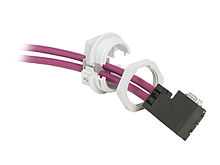Cable gland

_008.jpg)

A cable gland (in the U.S. more often known as a cable connector or fitting) is a device designed to attach and secure the end of a cable to the equipment.[1] A cable gland provides strain-relief and connects by a means suitable for the type and description of cable for which it is designed—including provision for making electrical connection to the armour or braid and lead or aluminium sheath of the cable, if any. Cable glands may also be used for sealing cables passing through bulkheads[2] or gland plates.
Cable glands are mechanical cable entry devices and can be constructed from metallic or non-metallic materials. They are used throughout a number of industries in conjunction with cable and wiring used in electrical instrumentation and automation systems.
Cable glands may be used on all types of electrical power, control, instrumentation, data and telecommunications cables. They are used as a sealing and termination device to ensure that the characteristics of the enclosure which the cable enters can be maintained adequately.
These are the four main materials from which cable glands are made:
Although cable glands are often called "connectors", a technical distinction can be made in the terminology, which differentiates them from quick-disconnect, conducting electrical connectors. The distinction is often not made.
For routing pre-terminated cables (cables with connectors) there can be used split cable glands. These cable glands consist of three parts (two gland halves and a split sealing grommet) which are screwed with an hexagonal locknut (like normal cable glands). Thus, pre-assembled cables can be routed without removing the plugs.
Alternatively there can be used split cable entry systems (normally consisting of a hard frame and several sealing grommets) to route a large number of pre-terminated cables through one wall cut-out.
There are at least 2 types of thread standard 1) PG standard 2) Metric standard ( millimeter )
See also
- Electrical connector
- Pipe thread
- Steel conduit thread
- Feedthrough
Sizes
| Thread nominal size |
Outer diameter [mm (in)] |
Threads per inch (TPI) |
Pitch [in (mm)] |
Inner diameter [mm (in)] |
Cable diameter [mm (in)] |
|---|---|---|---|---|---|
| PG7 | 12.5 (0.492) | 20 | 0.05 (1.270) | 11.28 (0.444) | 3 to 6.5 (0.118 to 0.256) |
| PG9 | 15.5 (0.610) | 18 | 0.05556 (1.4112) | 13.86 (0.546) | 4 to 8 (0.157 to 0.315) |
| PG11 | 18.6 (0.732) | 18 | 0.05556 (1.4112) | 17.26 (0.680) | 5 to 10 (0.197 to 0.394) |
| PG13.5 | 20.4 (0.803) | 18 | 0.05556 (1.4112) | 19.06 (0.750) | 6 to 12 (0.236 to 0.472) |
| PG16 | 22.5 (0.886) | 18 | 0.05556 (1.4112) | 21.16 (0.833) | 10 to 14 (0.394 to 0.551) |
| PG21 | 28.3 (1.114) | 16 | 0.0625 (1.5875) | 26.78 (1.054) | 13 to 18 (0.512 to 0.709) |
| PG29 | 37.0 (1.457) | 16 | 0.0625 (1.5875) | 35.48 (1.397) | 18 to 25 (0.709 to 0.984) |
| PG36 | 47.0 (1.850) | 16 | 0.0625 (1.5875) | 45.48 (1.791) | |
| PG42 | 54.0 (2.126) | 16 | 0.0625 (1.5875) | 52.48 (2.066) | |
| PG48 | 59.3 (2.335) | 16 | 0.0625 (1.5875) | 57.78 (2.275) | |
References
- ↑ "Cable Glands - What Are They". Retrieved 18 November 2013.
- ↑ "GlobalSpec: About Cable Glands". Retrieved 15 July 2010.
- British Standard BS 6121
- European Standard EN 50262
- VDE 0619:2005-05